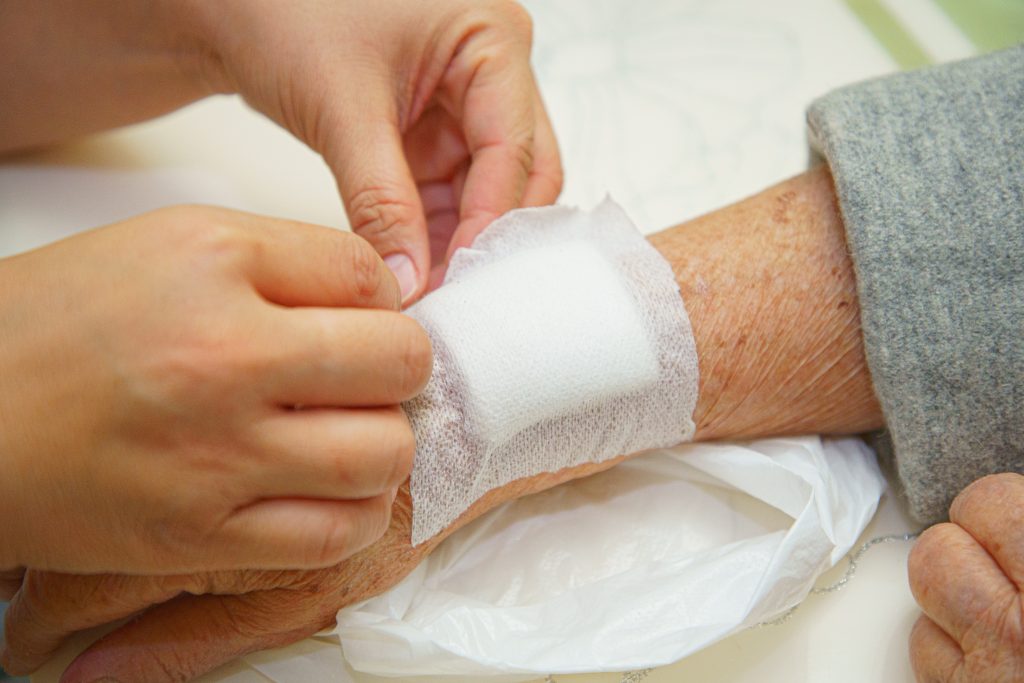Wound care dressings speed up the wound healing process by maintaining the ideal temperature and humidity, preventing bacterial infection, and ultimately providing the right environment for healing. Different wound dressings offer unique healing qualities for several wound types. Thus, incorporating the right wound dressing into wound care is crucial for patient healing, comfort, and overall well-being.
What are Wound Care Dressings?
Wound dressings are materials ideal for covering wounds and expediting the healing process. According to Broughton and his team, wound care professionals widely opt for traditional wound dressings, such as cotton pads, gauze, and bandages, due to their simplified manufacturing processes and low costs.
Although several wound dressing types are suitable for different wounds, their primary function includes minimizing infections and optimizing wound healing. Moreover, wound dressings are essential for stopping bleeding, promoting blood clotting, absorbing excess moisture, and wound debridement.
Modern-day wound dressings also provide the moist environment necessary for wound healing. Unlike traditional, these modern dressings offer high moisture retention, degradability, and biocompatibility. These capabilities significantly aid pain reduction and hypoxic/anaerobic environment improvement.
Qualities of an Ideal Wound Care Dressing
The wound type is a top factor determining dressing materials wound care professionals select. Other selection factors for the ideal wound dressing include its ability to:
- Enhance epidermal migration
- Provide and maintain a moist healing environment
- Maintain appropriate temperature for improved blood flow to the wound bed
- Not adhere to the wound and allow easy removal after healing
- Protect against bacterial infection
- Allow the exchange of gas between the environment and the wounded tissue
- Be sterile, non-allergic, and non-toxic
- Provide debridement action for enhanced migration of leukocytes
- Support enzyme accumulation
Types of Wound Care Dressing and Their Applications
Knowledge of the different types of wound care dressing is necessary to simplify the selection process. Studies have shown that each is ideal for particular wound types. Thus, this section highlights some common types of wound dressing and when to use each.
Cloth
Cloth wound dressings come in several shapes and sizes, allowing easy modification to fit any wound. This type of dressing is suitable for minor wounds, such as cuts, bruises, and injuries located in delicate areas; since it easily conforms to the human body. Moreover, professionals leverage this wound dressing type as the first layer of protection and sometimes the second layer to secure the first. Thus, the cloth wound dressing is the most widely used by wound care professionals.
Foam
This wound dressing type promotes a healthy moisture balance in wound sites. Although it allows access to water vapor, cloth dressing prevents bacterial entry into the affected area. Moreover, foam dressings remain ideal for wounds that exhibit odors since they can absorb wound exudates from the site and create an environment that promotes faster healing. Depending on the requirements of the wound care professional, foam dressings come in several variants, including adhesive and non-adhesive.
Transparent
Transparent dressings are ideal in cases where healthcare professionals prioritize wound site monitoring. For instance, professionals may need to monitor patients with surgical incisions, ulcers, burns, and intravenous (IV) insertions for infections and other possible complications. In addition to easy monitoring, using transparent dressings can allow caregivers to speed up the healing process. Additionally, transparent dressings come in a highly flexible thin film, maximizing their comfort at the wound site.
Alginate
Due to their absorbent nature, alginate dressings are appropriate for wounds with excess exudates, such as venous ulcers, burns, and high-state pressure ulcers. Alginate comprises sodium and seaweed fibers accounting for high absorbency and gel-like substances that expedite wound healing. Moreover, professionals must only use this dressing for wet wounds as excessive drying and bacterial penetration inhibit wound healing.
Hydrogel
Hydrogel is ideal for dry wounds because it supplies moisture that can ensure faster breakdown and healing of the dry, dead tissues. Hydrogel dressing also promotes patient comfort and reduces pains caused by dead tissues. Hydrogel dressings are also suitable for pressure ulcers, donor sites, necrotic wounds, infected wounds, and second-degree burns. Hydrogel dressings sometimes contain cooling gels for extra patient comfort and rapid wound healing.
Collagen
Wounds covering a large surface area require collagen wound dressings. Collagens expedite the wound healing process by removing dead tissues, supporting the growth of new blood vessels, and tightening wound edges. This type of dressing aids the healing of transplant sites, burns, surgical wounds, pressure sores, chronic wounds, ulcers, etc. The capabilities of collagen dressings allow them to act as temporary second skins required for the growth and flourishing of new cells.
Hydrocolloid
This non-breathable, self-adhesive dressing type supports the healing process by creating a moist wound healing environment. Hydrocolloid dressings can absorb water and form a gel since they are surface-coated with polymer-containing substances and polysaccharides. The dressing then applies this gel to the wound site. It is noteworthy that hydrocolloid dressings are the longest-lasting types of dressings and the easiest to utilize due to their self-adhesive capabilities.
Bottom Line
Selecting the ideal wound dressing is required to expedite the wound healing process and maximize patient satisfaction. Ideal wound dressings exhibit several qualities, including the protection against infection, provision and maintenance of a moist healing environment, and maintenance of the appropriate temperature for improved blood flow. Modern-day wound dressing, such as foam, alginate, cloth, transparent, hydrogel, collagen, and hydrocolloid, exhibit these qualities depending on the wound type, surface area, drainage, and other factors.



.webp)

.avif)